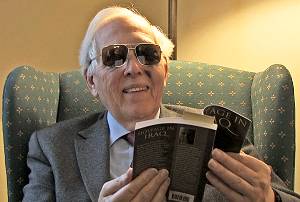
|
The world of non-commercial film and A-V |
Events Diary | Search | ||
| The Film and Video Institute | | ||||
To BIAFF 2011 results | To Full Making Of Index Anatomy of a Song - beginningAnatomy of a Song is the story behind the song A Vulnerable Man based in part on the book Hostage in Iraq by Norman Kember. |
The film won 5-Stars and a Sponsors Award from AKM Music at BIAFF 2011. We asked Philip to write about the film. His first article was good but dealt with just one aspect of the film. So we asked for more; got more. Still not satisfied, we asked for more; got more. Sensing there was even more to hear, we pestered him again ... What has emerged is a picture of a film maker's life, which may ring bells with many people in a similar position. No matter how dedicated you are to a project, life keeps getting in the way. Thanks for your patience and frankness, Philip. - Jan & Dave Watterson |
|
Beginning
I had been invited by a former work colleague, Tony Kempster, to make
a record of a group of peace activists as they rehearsed and recorded their
second CD.
Fortunately the recording studio chosen was just a ten minute walk from my
Buckingham home. The recording sessions were a joy to behold. A group of
varyingly talented part-time musicians, mainly with full time jobs and so
available in various combinations at various times. I had decided to shoot in HDV, downscaling could be left till later. One of the songs was inspired by the misadventures of Norman Kember in Iraq and this always seemed the most likely candidate for general consumption especially as its composer, Sue Gilmurray was one of the leading lights in the whole project. |
|
|
The First Interview
It had always been planned to interview Norman as part of the CD project.
As I had the equipment and came cheap (well free actually) I was invited
to be the technician. Norman and his wife Pat were staying at the Randolph
in Oxford at a convenient date so a meeting had been arranged. I arrived
a few minutes early. |
|
|
Norman and Pat had gone out for a walk but when they returned I was introduced to them by Tony. Why was Norman wearing dark glasses? His story was that he'd had an argument with a paving slab and lost by two black eyes to nil. My speculation is that MI5 had heard that he was about to appear in one of my films and had done their best to scupper the whole enterprise. Norman was in Oxford to address a group at the Student's Union. |
 |
"If that was me," I said, "I would have been sorely tempted to declare, 'Half way up I met the barrel coming down!'" "Well," said Norman, "When I apologised for my appearance I did say 'I received a severe injury' but they didn't get the reference." So much for the youth of today, completely unaware of the history of places they inhabit. For those of a younger generation or those who suffer memory lapse I refer you to the BBC sound recording of Gerrard Hoffnung's address to the Oxford Union.* |
| Visually then the exercise was a waste of time, but we did
get a "just adequate" sound recording despite the constant background noise
of the hotel's air conditioning unit and the Oxford traffic. One thing Norman
mentioned was that it would have been much easier with "an idiot board".
I pointed out that while I might be near the genius level when it comes to
filming even I couldn't prepare an idiot board with words only he had a copy
of. We all chuckled. (Nobody mentioned totalitarian regimes.) |
||
|
Anatomy of a Song continues... 2 - making
plans | 3 - diversions |
4 - more diversions |
5 - editing |
6 - editing again
|
||
Share your passions.

Share your stories.
